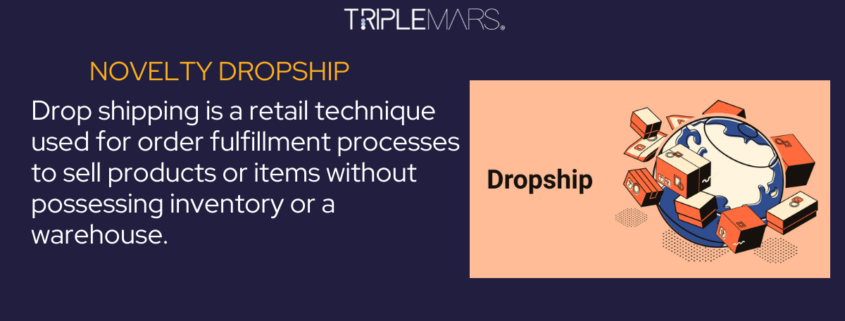NOVELTY DROPSHIP
Wondering if you can start your business with perks and freedom? Well, Drop shipping is the perfect answer for that.
In this comprehensive guide, you will learn in detail about drop shipping, it’s working, supply chain, processing, business mode, benefits, disadvantages, legality, profitability, and right approaches. Let’s study.
What Is Drop Shipping?
Besides, when drop shippers receive any order then they sent customers’ information, product order number, shipping address, and other related data to the third party. They further handle packaging, labelling, and shipping of those orders to customers.
Also, note that the primary difference between traditional retail fulfilment and drop shipping is of a warehouse. It means the latter (drop shippers) do not have to own or handle inventory or warehouse to sell products.
How exactly does Dropshipping Work?
Suppose, you find a product for $10 on a supplier’s website. The next step is that you list the same product at $30 on your website. Further, customers will reach your website via seeing promotional ads, Facebook posts, blogs, or more. They will explore your website and place an order and makes the payment to you.
Then further your work comes into action. You need to place an order with your supplier by utilizing customer information. Further, the product will be directly shipped to your customer and generates a profit of $20.
So, unlike traditional business, you are not handling any such business aspects such as production, packaging, labelling, and shipping. Instead, you don’t even have any hands on the products. But still, you are selling those products and generating profit. That’s how dropshipping works.
This is how you generate profit for each item you sell on your website. However, make sure you keep the product cost in accordance with market value. Also, overpricing will only waste your time and efforts.
Drop shipping Fulfillment: Understanding The Supply Chain
Supply Chain is a lavish term employed for the method of shipping the products or items from manufacturers to customers. Drop shipping supply chains have three main aspects. It includes manufacturers, wholesalers, and retailers.
As the name suggests, manufacturers create or produce products. And, sell them in bulk to wholesalers and retailers. Note that, manufacturers do not directly sell products to customers.
In addition, if you want to purchase products directly from the manufacturers removing the intermediate parties, then you can purchase them at lower costs. Then, you can resell those products ahead. Nevertheless, most manufacturers have minimum purchase requirements that you have to meet. Also, while trading products to customers, you have to stock and re-ship products.
Next comes Wholesalers. They purchase products from manufacturers in high volume and sell them to third parties. This third party is called a retailer. They sell products to consumers. In addition, wholesalers tend to process in a specific industry. Also, wholesalers’ processes sell to retailers and not directly to customers. Eventually comes retailers. They directly sell products to customers at a markup. If you are a drop shipper then you are working as a retailer.
Talking about drop shippers, they are the silent part of the supply chain as they have no power over any aspect of the supply chain process. Therefore, monitoring supply chain management is an important aspect to integrate all systems to streamline the process. Let’s simplify, wholesaler deals with logistics and products. And, drop shipper deals with sales, marketing, and customer service.
To streamline the entire process, the supply chain model works as a mechanism in this system. It permits drop shippers to monitor sales, inventory, customers, market, and more. Lastly, use all those combined factors to improve the efficiency of the order fulfilment process.
The Drop shipping Process
Here are the simple steps that are involved in the drop shipping process:
- Select the product to sell on your eCommerce website
- Find and locate a genuine supplier for your business.
- Promote your products on social media channels.
- The customer places the order and pays for the product.
- Drop shippers place orders with their suppliers.
- Suppliers ships the product to customers.
- Once customers receive the product then follow up with the sale.
Explaining the Dropshipping Business Model
Drop shipping business models include three crucial aspects that make this process work. These three elements include:
- Manufacturer
The first part includes the Manufacturer. They manufacture products, handle inventory, ship, replace faulty products, and restock goods. Further, they sell products in bulk at wholesale prices (assuming the risk of unsold inventory) to retailers.
- Retailer
The next part includes Retailers. Drop shippers come under this category. The major part of a retailer’s work includes marketing and selling products on their website. Moreover, they have to handle customers’ complaints and concerns. They are solely responsible for handling customer service as well.
- Customer
The next category includes Customers. If they get attracted to your products and services they will visit your website. Then they will purchase items or products, and make the payment to retailers. Then retailers have to order further from suppliers. Lastly, suppliers ship the products to customers.
Getting Started with Dropshipping
If you are a beginner drop shipper and worried about starting your drop shipping business then we have your back to guide you. Read further on how to start your drop shipping business.
The first and foremost aspect of the drop shipping business is to find a Niche. Select a niche based on your interest and knowledge. Further, you need to do extensive research to find the potential products for selling and narrow them down. It should be based on profitability, market value, and more.
Moreover, track what your competitors are up to and learn about the market. For keywords that will help your customers to reach you. Furthermore, make sure to invest in social media engagement.
The secondary step includes finding the right suppliers. It is a daunting task. However, make sure to choose genuine and trustworthy suppliers on whom you can rely on your business. Because the solid base of your drop shipping business is covered by suppliers themselves. Therefore, it is important to make the right decisions while choosing suppliers.
Further, you need to have your own website. Your potential customers will reach you and your services by coming to your website. Now, once they are on your website they will explore products and decide what to buy. So, it is important to make your website user-friendly and easy to access. Note that there exist certain platforms that will help you to build your website such as Shopify. Make sure to use software tools to track and analyze the market and your potential customers.
Note this Tip:
The most important tip is to optimize your website. Make sure you optimize your site with primary keywords and Search Engine Optimization (SEO). Also, make the best use of Facebook and Google Ads, Email Marketing, and Social Media.
The final step includes marketing strategies to target and attract potential customers. Do not forget to promote your products or services on social media channels such as Facebook, Instagram, Twitter, and more.
Benefits of Dropshipping
Here’s the list of drop shipping benefits. Check them out:
- Lower Startup Cost
The most amazing aspect of drop shipping is that you don’t require huge cash flow to put resources into stock forthright. However, all you need is the right business strategy that would help you to invest capital in the right sources.
Moreover, you don’t have to own an inventory or warehouse. Also, you are free from handling other workloads such as packaging, labelling, shipping, and more. Also, there’s less danger in spending capital on unsold merchandise, testing product offering expansions, and beginning an outsourcing store.
- Scalability
It is quite accessible for drop shippers to scale instantly because they don’t have to handle order fulfilment, which relies upon location and other aspects. In addition, drop shippers can help to benefit retailers that have to deal with sales fluctuation due to certain reasons.
- Easy Process
Drop shipping is quite a simple and easy process to start with. There are certain aspects that you don’t have to deal with in the drop shipping business. It includes managing products, possessing inventory, handling packaging/labelling/shipping, stocking goods, and organizing and tracking products. You can see that half of your workload is already off your shoulders. And, all you have to handle is sales and marketing.
- Broad Products
When you are in the drop shipping business, you are not restricted to a limited number of products or items. Instead, you are open to a wider range of product opportunities. Also, you can research the trending products and sell them on your website that suppliers have in stock at no additional cost.
- Flexibility
With a drop shipping business, you also have flexibility in certain terms. It means you can access and operate your business from anywhere and anytime. In addition, you can sell a variety of products according to market preferences.
- Inventory Management
Drop shippers are free from managing and handling certain elements. They don’t have to waste their time tracking inventory, shipping, and more. Drop shipping removes the need to maintain physical inventory and it also reduces the overhead that retailers face.
Disadvantages of Dropshipping
No business is perfect and every business has certain downsides and challenges. Here is the list of drop shipping disadvantages. Let’s check:
- Third-Party Suppliers Errors
In the drop shipping business, retailers are primarily dependent on third-party suppliers. In case, any hazard occurs from the suppliers’ end such as low-quality products, labelling, shipping, or more. Then retailers have to face the negative consequences. They might lose long-term customers, money, and even trust. It might severely affect your business reputation as well.
It is obvious that drop shipping offers freedom from a certain workload. But it also comes with a high level of risk. You are not aware of the quality of products, shipping procedures, and more. And, this causes disruption in the process.
- Highly Competitive
With substantial growth in the drop shipping business, competition is also increasing. It is harder for drop shippers to stand out from the crowd in the online selling market. Therefore, you need strategic planning and exceptional customer service from your and suppliers’ end to maintain efficiency.
- Inventory Management Issues
Inventory stocks come and go almost every day. And, drop shippers do not handle inventory stocks that add complexity to the process. To fulfil customer orders you need to have knowledge of stock availability. But, it’s not the case when retailers rely on suppliers for stock.
- Customer Service
If customers face any concerns regarding products or shipping. Then they will contact retailers. Further, retailers who do not have power over inventory have to get in touch with suppliers to resolve the concern. And, it disrupts the workflow in case some issues arise from the supplier’s end.
- Profit Margins
Drop shippers’ revenue gets lowered because their outsourcing order fulfilment is dependent on third-party sellers. To obtain the same revenue as that of traditional retailers, drop shippers have to improve the sale volume.



















Leave a Reply
Want to join the discussion?Feel free to contribute!